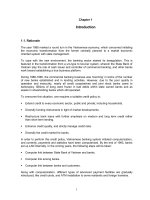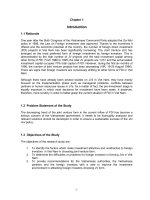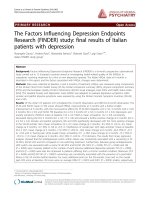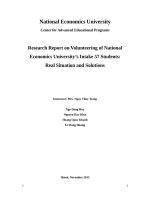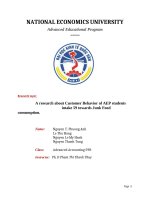Final Research (3)
Bạn đang xem bản rút gọn của tài liệu. Xem và tải ngay bản đầy đủ của tài liệu tại đây (317.24 KB, 48 trang )
Chapter 1
Introduction
1.1 Rationale
One year after the Sixth Congress of the Vietnamese Communist Party adopted the Doi Moi
policy in 1986, the Law on Foreign Investment was approved. Thanks to the incentives it
offered and the economic potential of the country, the number of foreign direct investment
(FDI) projects in Viet Nam has been significantly increasing. The Joint Venture (JV) has
emerged as the most preferred form of foreign investment by foreign investors. This is
demonstrated by the high number of JV projects and the total investment capital among other
forms of FDI. From 1988 to 1995, the total JV projects are 1,031 and the accumulated
investment capital occupies 70% total capital of FDI. However, during the first six months of
1996, the number of joint venture projects has been decreasing (VIR, 19-25 August 1996).
There are signs that foreign investors are consciously shifting to other forms of FDI in Viet
Nam.
Although there have already been several studies on JVs in Viet Nam, they have mainly
focused on the implementation phase such as managerial problems, conflicts between
partners or human resources issues in JVs. As a matter of fact, the pre-investment stage is
equally important in which most decisions for investment have been made. It deserves,
therefore, more scrutiny in order to better grasp the current situation of FDI in Viet Nam.
1.2 Problem Statement of the Study
The decreasing trend of the joint venture form in the current inflow of FDI has become a
serious concern of the Vietnamese government. It needs to be thoroughly analyzed and
relevant solutions should be developed in order to ensure a sustainable success of the doi
moi policy.
1.3 Objectives of the Study
The objectives of the research study are:
1. To identify the factors which make investment attractive and unattractive to foreign
investors in Viet Nam in choosing joint venture form.
2. To determine the difficulties or problems for foreign investors in forming JVs in Viet
Nam.
3. To provide recommendations for the Vietnamese authorities, the Vietnamese
partners and the foreign investors with a view to improve the investment
environment in attracting foreign investors choosing JV form.
1.4 Research Methodology
1.4.1 Information Needs
-1-
To achieve the objectives of the study, the following information were needed to be collected:
• The government regulations concerning foreign direct investment in Viet Nam, especially
joint ventures (secondary data).
• The favorable and unfavorable factors for foreign investors forming joint ventures in Viet
Nam (primary data).
• The difficulties or problems for foreign investors forming joint ventures in Viet Nam (primary
data and secondary data).
• Opinions on how to improve the investment environment for foreign investors forming joint
ventures in Viet Nam. These were collected from foreign investors, Vietnamese partners, as
well as from the business experts/consultants and government policy makers (primary
data).
1.4.2 Data Collection Methods
The information needs were collected from:
a. Secondary data: a desk research on the FDI was carried out. This exploratory study was
mainly based on the secondary data which were available in various newspapers, magazines,
official documents.
b. Primary data were obtained from in-depth interviews with business experts/consultants of
CESAIS (Centre For Economic Studies and Applications), government officials in Ho Chi Minh
City, officials of the former SCCI and FDI promoters in Viet Nam, particularly those from
Korea, Taiwan, Hong Kong, Singapore.
Beside personal interviews, a mail survey was also conducted with the assistance and support
of the CESAIS members. A total number of 200 questionnaires were delivered to foreign
investors and Vietnamese partners who were sampled from the comprehensive “List of FDI by
the End of April, 1996”, in Viet Nam Info, compiled by the VCCI. The questionnaire was
developed to serve the objectives stated in section 1.3.
To ensure a high response-rate, we constantly used follow-up telephone calls to remind the
respondents about the questionnaire. An additional questionnaire was sent out in case the
respondents did not receive one in the first mailing.
Despite all the efforts, we were able to collect only 40 questionnaires, representing a response
rate of 20%. Among these 40 returned questionnaires, 3 were considered invalid because of
various reasons: due to missing page of the questionnaire, blank questionnaire for any
reasons. Consequently, we finally had 37 usable questionnaires for analysis. The list of
respondent companies is shown in Appendix C.
1.4.3 Data Processing
Data from the mail survey were inputted via Microsoft Excel 5.0 with initial screening.
Secondary screening was done when converting the Excel file to SPSS format. All the
calculations and tabulations were done via SPSS and Excel for Windows.
-2-
For data analysis, the mean score of each factors from the SPSS results will be mainly used
to illustrate the discussions of findings.
1.5 Scope and Limitations of the Study
The study only covered FDI in Viet Nam, and focused especially on the joint venture form. It
mainly considered the reasons or factors which make foreign investors choose or do not
choose joint venture among forms of FDI.
The survey was only conducted in Ho Chi Minh City. It, therefore, does not reflect the situation
of the whole country.
1.6 Organization of the Study
This report is presented in 5 chapters.
Chapter 1 is the introduction. It includes the rationale, problem statement, objective, research
methodology, scope and limitations, and organization of the study.
Chapter 2 is literature review consisting of three parts: the first part will provide a general
understanding about joint venture; the second part is the benefits and difficulties of joint
ventures; the third part is the problems faced by joint ventures in developing countries.
Chapter 3 presents the current situation of foreign investment in Viet Nam. This includes the
government policy on foreign direct investment, the current status of foreign direct investment
and joint venture in Viet Nam.
Chapter 4 contains the major findings and discussions that were collected through
questionnaires and in-depth interviews with business experts/consultants and policy makers in
Ho Chi Minh City.
Chapter 5 provides conclusions and recommendations to the Vietnamese government,
Vietnamese partners, as well as foreign investors for consideration.
Chapter 2
Literature Review
2.1 Definition of Joint Venture
-3-
There are different definitions about joint ventures. For this research study, the following
seems to be most relevant:
A joint venture is a cooperative business agreement between two or more firms that want
to achieve similar objectives. This agreement usually involves the creation of a new
corporate entity to satisfy the mutual needs of all parties involved (Bae, 1990).
2.2 Benefits and Difficulties of Forming Joint Ventures
Joint venture is a form of FDI. It is popular over the world. Joint ventures often have benefits
as well as difficulties.
2.2.1 Benefits of Joint Ventures
The benefits of joint ventures are presented in the following table:
Table 2.1 Benefits of Joint Ventures
No. Benefits
1. Facilitates technology transfer:
codification/public knowledge
converting head knowledge to production
impact of technology on marketing relationships
discovery of price of technology
2. Access to resources:
rapid products diversification strategies as means of corporate growth
favors joint ventures
provides funds and assets to local capital markets
each partner concentrates resources on an area of greatest advantage
avoids necessity of developing international management skills
access to knowledge of local environment and markets
may reach critical mass for internationalization
more efficient competitive position
3. Political pressures:
host country pressure for local participation
local control of job creation and technology transfer
preferential treatment (remittance of royalties)
may avoid local tariffs and non-tariff barriers
4. Access to markets:
quick and efficient access to distribution
by-passed trade barriers
image/attitude to local company
5. Other reasons:
good public relations
curbs potential competition
-4-
• provides temporary relief for weak product portfolio
Source: Bradley (1991)
2.2.2 Difficulties of Joint Ventures
The difficulties of joint ventures are shown in the following table:
Table 2.2 Difficulties of Joint Ventures
No. Difficulties
1. Loss of control over foreign operations
large investment of financial, technical or managerial resources favors
greater control than is possible in a joint venture
2. Joint ventures are difficult to co-ordinate
lack adequate procedures for protecting proprietary information
shared decisions affect global marketing arrangements
3. Loss of flexibility and confidentiality
changes in product-market mission may make joint venture a liability
unease about sharing technology
one partner may form alliance with other partner’s competitor
• managerial dependency between joint venture and one of partners
Source: Bradley (1991)
2.3 Problems and Difficulties of Joint Ventures in Developing Countries
In developing countries, joint ventures often face problems related to general issues, partner
selection, negotiation, management, and problems related to host country environment.
2.3.1 General Issues
Experience has learned that joint ventures are difficult to manage and frequently unstable. A
survey conducted in 1985 showed that there was a failure rate of 30% in developing countries
(Columbia Journal of World Business, 1985). A major reason for this high failure rate is the
structural complexity that makes a joint ventures difficult to manage, regardless of the contrast
between their parent environments (Shenkar and Zeira, 1992:55-75).
In particular, international joint ventures are unique and problematic in their combination of two
major hurdles: multiple national affiliation and multiple ownership (Shenkar and Zeira, 1992:55-
75). Multiple national affiliation means that international joint ventures bring together parent
companies that are anchored in environments differentiated by culture, political, economic and
legal systems. Multiple ownership means that international joint ventures are owned, and often
managed, by at least two parent firms. Because of this combination, international joint
ventures are probably more problematic to manage than other forms of foreign direct
investment (Shenkar, 1990: 82-90).
In the study of strategic assessment of international partnership in ASEAN countries, Lasserre
(1983) has identified the perceived sources of problems in this geography which is shown in
Table 2.3. The major sources of problems were those related to behavioral problems and
conflicts, and misunderstanding or attitudes.
-5-
Table 2.3 Perceived Sources of Problems in Foreign Operations in ASEAN Countries
As perceived by foreign partner (%) As perceived by local partner (%)
General conditions 30 General conditions 35
- Change in economic condition - Competition
- Devaluation - Government regulation
- Imitative competition - Bad debts
Government policies 23
- Local content push
- Bureaucracy
- Remittance
Behavior of local partner & employees 47 Behavior of foreign manager 65
- Lack of managerial skills - Lack of trust
- Absenteeism - Lack of experience
- Poor motivation - Too many expatriates
- Lack of dynamism of local partners - Too high technology expectation
- Lack of trust from local partner - Too high sales growth
- Lack of communication
Source: Lasserre (1983)
On the other hand, Table 2.4 demonstrates that the sources of the problems as perceived by
partners in successful partnership were more behavioral in nature. The application from this is
that if there are unsatisfactory cases of joint venture, problems are mostly caused by
partnerships.
Table 2.4 Perceived Sources of Problems in Satisfactory and Unsatisfactory Partnership
between European and ASEAN Firms
Cases
Problems linked to
general conditions
and government
Problems linked to
behavior of partner
and employee
Total number of
cases
Satisfactory 16 8 24
Unsatisfactory 19 28 47
Total 35 36 71
Source: Lasserre (1983)
2.3.2 Partner Selection
The study of Beamish and Lane (1990: 87-102) on joint ventures in developing countries
shows that identifying and selecting a partner is possibly the most important consideration in
establishing a cooperative venture. It may also be the most difficult and time consuming
venture. Even though partner selection could be the determining factor in making a business
partnership a success or failure, it usually is not given the time and attention that it deserves.
Firms are often in a hurry to find a partner in order to quickly enter an attractive market. As a
result, they are careless in their selection process and often mistakenly select a poorly
qualified partner in their desire for quick action and not to miss the business opportunity.
Partners are often selected only for short-term and political reasons. When the situation
changes and the partner has nothing more to offer, the relationship may come to an end.
The selection of suitable partners has equally become more problematic because most
developing countries do not possess sufficiently coordinated information systems. In
summary, problems that may arise during the selection of partners for joint ventures are
(Blodgett, 1991):
-6-
◊ Less time and attention being given to selection process
◊ Limit information on the partners
◊ Careless in selection, and
◊ Less attention being given to the assessment of the capability of the partners in
comparing alternatives.
2.3.3 Negotiations
Negotiating a joint venture agreement differs from case to case, but it normally include
financing, capitalization of know-how, products and markets, the business plan, reporting and
meeting procedures, board representation, selection and approval of key people, supply of
materials, components, and services by the partners, transfer of and payment for technology,
independent audit, dividend payment, minority shareholders protection, and buyout and
termination procedures (Berlew, 1984: 48-54).
The negotiation to form a joint-venture is a long and arduous process in many countries. A
description of the major sources of concern and the elements of difficulties during the
negotiations for both foreign and local partners are shown in Table 2.5 and 2.6 (Lasserre,
1984: 42-49).
Table 2.5 Elements of Importance during the Negotiations
Issues Frequency of answers
European
Partner
Local Partner
- Financial terms of the agreement 60% 50%
- Marketing aspects: distributorship, 20% 17%
brand, protection of share, quota
- Technical elements 10% 11%
- Legal characteristics: owner, control,
duration of contract
10% 22%
Source: Lasserre (1984)
Table 2.6 Elements of Difficulties during the Negotiations
Issues Frequency of answers
European Partner Local Partner
- Share evaluation 5 -
- Government interventions and constraints 3 4
- Duration of contract 2 -
- Royalties 2 -
- Change of person 2 -
- Financial transactions 1 -
- Defining responsibilities and ownership 1 1
- Commission on equipment 1 -
- Quota-evaluation of market 1 -
- Language - 2
- Price of equipment - 1
- Credit terms - 1
- Transfer pricing - 1
-7-
- Brand names - 1
- Speed of setting up equipment - 1
- Exclusively of joint venture - 1
Source: Lasserre (1984)
The major concerns of both partners are often related to the financial aspects of the
agreement, e.g.: share evaluation, intangible asset evaluation (when parts of the shares of the
foreign partner are constituted by patents or a trademark) or asset evaluation (when it is
constituted by equipment). Dividends, royalties, and management fees are also part of the
major items to be discussed.
Lasserre (1983) also shows that the negotiation process is not instrumental, either as a tool
for mutual knowledge or as a means for anticipating the major sources of future problems in
an industrial joint venture. Technological elements relating to the production process and to
the effective means of transferring know-how remain hidden until financial, commercial and
legal aspects are discussed at length.
The partners embark on an industrial venture without any prior knowledge of each other or
mutual understanding of the crucial issues they are likely to face, which in the future will make
their venture difficult to manage.
In some countries, negotiations are further complicated by cultural, legal and bureaucratic
factors which sometimes bring prospective foreign parents to a point of despair (Robinson and
Richard, 1964). For example, in the case of China, the Chinese often bring too many people to
the negotiating table. Chinese representatives are usually acting merely as messenger boys
for their absent bosses (Eiterman, 1990: 59-66).
2.3.4 Management of Joint Ventures
The problem in managing joint ventures stem from one cause: there is more than one parent.
The owners, unlike the shareholder of a large, publicly owned corporation are visible and
powerful. They can and will disagree on just about anything: How fast should the joint venture
grow? Which products and markets should it encompass? How should it be organized? What
constitutes good or bad management? (Ramanathan, 1992).
In particular, managing joint ventures in developing countries often encounter the following
difficulties:
a. Objectives/Interest of the Partners
The major problems relate to the conflict of interest between the two partners. These conflicts
may arise due to differences in opinions on the rate of production, level of output or dividend
policies. Conflicts can also arise on technological issues. The host partner may wish to expand
production through new capacity to enable exports, while the technology supplier partner may
be satisfied to install only that equipment which is necessary to serve the home market
(Ramanathan, 1992).
There may also be conflicts with regard to the nature and quality of output. The foreign
investor may wish to cut down the payback period whereas the local partner may be
-8-
interested in the growth of the company, which could lead to clear conflict of interest in
dividend policy (Lasserre, 1983).
There may be also no matching of objectives of the two partners. If it happens then there will
be great impact on managing the joint venture. This asymmetry of objectives is quite typical of
joint venture transaction, particularly those bringing together parents from developed and
developing countries (Shenkar, 1990: 82-90).
b. Board of Directors
The board of directors (BOD) has particular importance in all joint ventures. Because of the
multiplicity of parents’ headquarters and because of their frequently conflicting objectives, the
BOD tends to “take over” various managerial functions, serving as a “buffer” to conflicting
demands. The board decision making process is frequently cumbersome. In some cases, e.g.
China, the problem tends to be more serious because of bureaucratic interference (Shenkar,
1990).
c. Managing Human Resources
Many ventures encountered the problem of surplus workers (Park,1983: 105-126). The
problem may be particularly severe in international joint ventures which took over operating
plants from the local parents.
When skilled staff is available, the local parent is often reluctant to transfer it to the joint
venture and would prefer instead to transfer superfluous and less qualified personnel
(Shenkar, 1990: 82-90). Furthermore, overcoming personnel shortage by means of an
expatriate work force is difficult in the developing country due to legal constraints. Such
problems have been encountered in many developing countries (Bivens and Lovell, 1996).
Compensation is another problem for foreign expatriates in all joint ventures. For example, in
the People’s Republic of China (PRC), one such problem is downward pressure on expatriate
salaries generated by Chinese demands for parity of pay to foreigners and Chinese
employees holding similar titles (Cohen and Harris, 1986). Another major problem in the
developing country is replacing expatriate personnel within a few years, which make 'start-up'
costs for such personnel much higher.
Another problem may be that both host and foreign parent's managers who work for a joint
venture may have a conflict of loyalty between the venture and the parent companies. The
locals tend to remain loyal to their parent company rather than to the venture (Shenkar, 1990:
82-90).
d. Staffing
Usually, joint ventures that draw functional managers from both parents are more difficult to
manage than those that do not. Managers of all joint ventures may not only have
communication problems because of language barriers, they may also have different attitudes
toward time, the importance of job performance, material wealth and desirability of change.
These differences can delay the creation of an effective, cohesive management team (Killing,
1982: 120-177).
e. Foreign Exchange Repatriation
-9-
The major problem, particularly in recent years, concerns the depreciation of the host-
currency. The second problem of foreign investors arises from the risk of committing
resources to an underdeveloped country where a changing political structure may affect the
reliability of returns from the ventures (Shenkar and Zeira, 1992).
f. Transfer of Technology
Technology transfer is not without its consequences. The imported technology brings with it
many unwelcome elements of western culture (Afriyie, 1988: 51-62). Such elements as social
inequality and different perception of relations between people and nature were identified.
Some of the problems of technology transfer may be due to lack of effective leadership and
commitment to successful technology transfer in the developing countries (Madu, 1989: 115-
124). Another potential source of conflict is the desire of the foreign investor to keep full
control over the technology involved in the venture. In order to maintain the control of
technology in situation of conflict, the foreign investor seeks to maintain his monopoly over
technological change. The reason for that is also fear of losing competitive advantages, fear of
leakage for the benefits of other competitors (Ramanathan, 1992). Another main problem for
the foreign investor in technology transfer to developing country is the inadequate protection
of property rights, both patented and unpatented.
g Size and Direction of Exports
The desire for increasing exports in developing countries has frequently been in conflict with
the interests of the technology suppliers. This conflict has taken two major forms i.e., size of
the export flows and desire to affect the direction of the export flows. The host state may wish
to influence the direction of exports, because it may increase the price received for the
product, the size of potential markets, and because the government may have more general
strategic political interests. The technology supplier may resist these policies because they
conflict with the international competitive strategy of the firm (Kaplinsky, 1976: 197-224;
Ramanathan, 1992).
h. Taxation
A joint venture company has to pay turnover tax, income tax and a so-called tax on wages.
Taxes can be used effectively to increase the share of the host state. This may be an
important area of conflict. But, there are variety of mechanisms which the technology supplier
can use to evade these tax payments (Berg and Friedman, 1980: 143-168).
2.3.5 Problem Related to the Host Country Environment
All governments with restrict ownership policies have made exceptions for insisting on the
whole ownership. To counter this, foreign investors in India, for example, have found creative
ways to respond to the government’s demands. Sometimes they retained management control
of critical activities, while at other times they gained exceptions to the demand for shared
equity (Casseres, 1989: 17-26).
The attitudes of some countries toward foreign investment are not distinct. Legislation is
discriminatory in a number of countries, with too many restrictions on foreign investors.
“Forced negotiations” do not create a good impression on many investors (Alen, 1973). For
example, the discriminatory treatment to Japanese firms in Korea. Korea government
demanded that 97% of all locally produced Matushita products must be exported. The strong
-10-
pressure by the Korean government on Japanese firms to use Korean parts and components
became another serious obstacle to them in Korea.
Another problem may occur when the host government has established a number of
restrictive policies to force foreign investors to transfer their shares in ownership to local
partners. Also the host government may applied strong pressure on the foreign investor to
give up its control of joint venture, and the foreign firm has little chance but to sell its
controlling share to local partner (Matshura, 1988). There may also be a discriminatory tax
system on foreign firms with heavy shares in joint ventures than those on with small shares.
Another possible problem is managerial conflict due to different cultures. For example, all
important decisions in South Korean corporations are made by the top owner, who is often
called “emperor”. The meeting of top executives are often called “imperial meetings”, whereas
in other country decision is made by consensus (Matshura, 1988).
There may also difficulty for foreign investors by procedures of immigration authorities which
will causes more harassment (Matshura, 1988).
Managers of all joint ventures may not only have communication problem because of
language barriers, they may also have different attitudes toward time, the importance of job
performance, material wealth, and the desirability of change (Shenkar and Zeira, 1992: 55-75).
Chapter 3
Current Situation of Foreign Direct Investment in Viet Nam
This chapter will present the government policy towards FDI, the current status of FDI and JV
in Viet Nam.
3.1 Government Policy on Foreign Direct Investment
In principle, foreign investment in Viet Nam is regulated by the Law on Foreign Investment
which was passed by the National Assembly on 29
th
December 1987 and subsequently
amended on 30
th
June 1990 and 23
rd
December 1992 respectively. This law is supplemented
by the regulations of 16
th
April 1993. In addition, a number of circulars and regulations have
been issued by Ministries, People's Committees and other state agencies to concretize and
guide the implementation of this law. Hereunder are some important features concerning FDI
in Viet Nam.
3.1.1 Types of Investment
At present, there are five main forms of FDI according to the Law on Foreign Investment
(SCCI, 1993).
1. Business Cooperation Contract (BCC): The BCC entered and signed between the involved
parties will stipulate rights and obligations of business results and benefits. This form will not
create a new business entity with juridical person status.
2. Joint Venture (JV, bilateral or multilateral): One (or more) Vietnamese party (parties)
together with one (or more) foreign party (parties) will jointly contribute their capital to set up a
new venture and jointly conduct business and share the benefits, risks and rights. The new
-11-
entity which shall enjoy the status of juridical person shall be required to have as its legal
capital, at least by 30% of the total investment capital. Exceptional cases will be decided by
SCCI (now MPI), the ministerial level body empowered to examine FDI projects and issue
investment licenses.
3. Enterprise with 100% Foreign-owned Capital: Under this form, the proposed enterprise is
wholly owned and operated by the specific foreign investor.
4. Production Sharing Contract (PSC): PSC is applied in oil and gas exploitation and other
exploitation areas.
5. Build - Operate - Transfer Contract (BOT): The form in which a Vietnamese government’s
authorized party and one (or multiple) foreign parties agree to pull their resources into the
building, and operating of a project (mostly infrastructure-related) for a specific period of time,
and transferring the project back to the Vietnamese government on expiration of the term
agreed upon.
3.1.2 Investment Sectors
In principle, foreign individual and organization can invest in any sector of the Vietnamese
economy. However, the following sectors are especially encouraged by the government:
• Implementation of major economic programs, export production and import-substitution
production.
• High-technology industries using skilled labor, investment for more intensive utilization of
the available resources and for raising output capacities of the existing economic
establishments.
• Labor-intensive production using materials and natural resources available in Viet Nam.
• Building of infrastructure, and
• Foreign currency-earning service industries: tourism, ship repair, port repair and other
services.
3.1.3 Investment Incentives
The Vietnamese government has provided various incentives for foreign investment. These
are listed below:
• Up to 100% ownership by the foreign company.
• Full remittance of profit and other income accruing to the company or its personnel.
• Full repatriation of capital upon sale or dissolution.
• Losses may be offset against profits of the next five years and any reinvested profits are
entirely exempted from tax.
• Exemption or reduction of import duties are also proposed, depending upon their nature
and volume. The foreign invested enterprise and the foreign partner to a business
cooperation contract shall be exempted from import tax in the following cases:
a) Equipment, machinery, spare parts, production and business facilities, including means
of transportation and material imported into Viet Nam for capital construction of the
enterprise.
b) Raw material, spare parts, accessories and material imported for production of export
commodities. Upon export in finished form, these commodities shall be granted a tax
refund proportional to the export of the finished products.
-12-
c) Patents, technological know-how, technological processes or technical services
contributed as part of the legal capital by the foreign invested enterprise shall be
exempted from taxes related to technology transfer.
In case of sale of the above items in Viet Nam, the foreign investors must obtain the
permission from the Ministry of Trade and pay the import tax in accordance with the
Vietnamese law.
The priority category includes investment which meets two of the following criteria:
a) Enterprises which invest no less than ten million US dollars
b) Enterprises which export at least 80% of their products or earn at least 80% of
their income in foreign currencies.
c) Enterprises which transfer at least two of the following kinds of technology:
• Technology which improves both the quality and quantity of the product,
• Technology which creates new products which Viet Nam needs,
• Technology which saves raw materials and energy.
d) Enterprises which have a very low profit rate.
e) Investment projects located in depressed areas.
In exceptional cases where encouragement for investment is needed, special financial
incentives may be granted to a JV as follows:
a) A cooperate profit tax varying from 10% to 14% of actual profit; and
b) Exemption of corporate profit tax for a period not exceeding 4 years and a 50%
tax reduction for another maximum period of 4 succeeding years, following the
first profit making years.
Normally, the company tax rate is set at 15-25% depending on either priority category (15% to
20% of profit) or standard category (21%-25% of profit).
• Tax on profit remittance overseas: foreign individuals or organizations are given the right
to remit abroad their salaries and other legal income after reduction of their income taxes
and living expenses in Viet Nam. The remittance tax rates specified in the table below:
Table 3.1 Remittance Tax
Rate of Remittance Project's Legal Capital Contribution (US$)
1 5% 10 million & over
2 7% 5 million & over
3 10% less than 5 million
• Financial operations of enterprises can be done through the Bank for Foreign Trade of Viet
Nam, branches of joint Vietnamese-foreign banks or any foreign banks in Viet Nam as may
be authorized by the State Bank of Viet Nam.
3.1.4 Investment Insurance
The foreign investment law ensures the foreign investor’s security of property, an effective role
in business management and possibilities of earning high profits. The invested capital,
property and assets of foreign organizations or persons shall not be requisitioned or
confiscated under any administrative procedure. The law also grants the rights to export the
-13-
capital, profit and other income managed by the enterprises. The law states that foreign
economic organizations and persons have the right to remit abroad:
• The share of profits accruing to them from business operations,
• Any approved payments for services or transfer of technology,
• The principle and interest on any loans made by them to the enterprises, and
• Any other sums of money and assets in their legal ownership.
In addition to the investment insurance specified in the Law on Foreign Investment, Viet Nam
is willing to sign a special agreement with any foreign enterprise in order to guarantee that
particular enterprise will have full protection from the government as far as investment is
concerned. To overcome the problem of double taxation, Viet Nam is willing to enter into
agreements with countries whose firms are investing in Viet Nam. So far, Viet Nam has signed
several agreements to this effect such as with France, Thailand, South Korea, the
Netherlands. Furthermore, the government has adopted additional regulations on customs,
immigration, residence and communications intended to create favorable business conditions
in Viet Nam.
3.1.5 Land Rental
The rental rate for land in urban areas shall be calculated by the following formula:
Y =X
1
*
X
2
*
X
3
*
X
4
Where: Y: land rental rate
X
1
:
minimum land rental rate of urban group
X
2
: location factor (X
2
=1 or X
2
=2)
X
3
: infrastructure composition factor (X
3
=1; 1.5 or 2)
X
4
: trade category factor (X
4
=1.2; 1.5 or 2)
Urban group 1:
US$ 2.25-18.0/m
2
/year
Urban group 2:
US$ 1.50-16.6/m
2
/year
Urban group 3:
US$ 1.50-12.0/m
2
/year
Urban group 4:
US$ 1.00-8.0/m
2
/year
Urban group 5:
US$ 0.50-4.0/m
2
/year
Rental rate for rural land is specified as follows:
• Land on rocky mountains or bare hills and uncultivated land: US$ 50-200/ha/year.
• Other kind of land: US$ 200-700/ha/year.
Projects using land for agriculture or forestry shall be exempted from payment of the
specified rental rate during the period that they do not turn out the products.
Project using land for other purposes shall be subject to the maximum payment of not over
50% of the specified rental rate during the period of exploring, surveying or capital
construction.
3.1.6 Stipulations on Labor in Foreign Invested Enterprises
-14-
Working Conditions
• Minimum wage: minimum wage is set at US$35 a month for employees in Hanoi and Ho
Chi Minh City and UD$30 outside these cities.
• Working hours: Eight hours a day with a maximum of hours a week.
• Holidays: One day off a week plus a minimum 18 days of paid leave a year. Seven and
half days are designated public holidays. Workers with 10 years continuous service, as
well as those employed in remote areas or carrying out highly toxic and dangerous jobs
are entitled to an additional five days off.
• Maturity leave: female workers are entitled to 12 weeks of maturity leave and with babies
under 12 months are an extra one hour break a day for feeding.
• Termination: The length of notice for termination is specified in the labour contract. The
minimum lengths of notice for the different types of contracts are 45 days for definite
labour contracts, 60 for indefinite labour contracts and 1 day for project- based contracts.
Recruitment
Foreign companies are not permitted to employ any Vietnamese below 18 years old, and in
the case of trainees, 16 years. They may recruit local labour in several ways: through the local
government-owned labour agency, by entrusting the task to labour supply companies or by
direct employment if the other two methods are inadequate. Expatriates may be employed
only if no Vietnamese can be found to fill a position.
Labour Contract
Labour contracts are required for the employment of Vietnamese. They should be based on
the model issued by the Ministry for labour, War Invalids and Social Affairs, i.e. they must give
a job description, specify the work place, wage/salary, duration of contract and probation
period, and provide social insurance and labour protection. Under certain circumstances, the
contract may be terminated. An employer may dismiss a worker for failure to carry out his
tasks, breach of discipline, serious injury or illness, or if the enterprise is forced to reduce
production.
Collective Labour Agreement
An enterprise with more 10 workers must sign a collective labour agreement with the workers’
labour representatives within six months after it begins to operate. The term of the agreement
must accord with the labour regulations and once signed, a copy must be registered with the
local labour agency. The agreement will be valid for a minimum of one year and a maximum
of three years, and should include details like salary, conditions of work, welfare and social
insurance.
Trade Union and Labour Disputes
All enterprises must allow their workers to form trade unions. In the case of disputes,
management and workers should negotiate for a settlement. If this fails, the two parties may
bring to arbitrate either through:
• A conciliation council comprising an equal number of representatives from both sides
presided over by the Minister of Labour, War Invalids and Social Affairs.
• A council established and presided over by the Minister of Labour, War Invalids and Social
Affairs.
-15-
3.1.7 Immigration and Residence
Foreigners who are entering Viet Nam to study and prepare for investment shall be granted a
multiple-entry visa which is valid for three months and can be extended every three months.
Foreigners engaged in the implementation of an investment project shall be granted a
multiple-entry visa which is valid for one year and can be extended every year in accordance
with the operation term of the project.
Entry visa shall be issued at Viet Nam diplomatic agencies or consulates abroad within at
least 5 days from the date of application for the visa.
3.2 Current Status of FDI in Viet Nam
The number of FDI projects and total investment capital are increasing year by year.
According to official statistics, by the end of 1996, the total licensed projects were 1,836 with a
total invested capital of US$26,233 billion (MPI, 1996).
Table 3.2 Growth of FDI in Viet Nam from 1988 to 1996
Year 88-90 91 92 93 94 95 96
Number of projects 218 155 193 265 343 336 326
Investment capital (US$ bil.) 1.615 1.278 1.967 2.688 3.588 6.282 8.815
Source: MPI (1996)
88-90
91
92
93
94
95
96
218
155
193
265
343
366
326
0 50 100 150 200 250 300 350 400
88-90
91
92
93
94
95
96
Year
Num ber of projects
Figure 3.1 Number of FDI Projects (1988-1996)
-16-
88-90
91
92
93
94
95
96
1.615
1.278
1.967
2.688
3.588
6.282
8.815
0 1 2 3 4 5 6 7 8 9
88-90
91
92
93
94
95
96
Year
Investment capital (US$ bil.)
Figure 3.2 Foreign Investment Capital (1988-1996)
The tempo of attraction of foreign investment capital has increased rapidly. The average
annual rate of foreign investment capital was 51.6 percent in the period between 1988 and
1992. The growth rate of total investment capital has steadily increased afterward: 54% in
1992, 37% in 1993, 45.4% in 1994, 75% in 1995, and 40.3% in 1996.
In terms of types of industry, the FDI projects were distributed as following:
Table 3.3 Foreign Investment by Types of Industry
Types of industry Number of projects Registered capital (US$)
1. Heavy Industry 282 4,049,704,349
2. Hotel, Tourism 149 3,956,163,506
3. Offices, Departments 106 3,210,486,790
4. Light Industry 304 2,570,454,658
5. Construction 139 2,159,649,283
6. Transport-Telecom 81 1,904,580,999
7. Food Industry 99 1,754,333,406
8. Oil Industry 27 1,264,575,000
9. Agriculture, Forestry 162 860,893,010
10. EPZ Construction 9 612,383,786
11. Education, Medicine 44 277,347,588
12. Service 38 195,202,013
13. Finance, Banking 23 188,871,900
14. Fishery 41 130,487,070
Total 1504 23,135,133,358
Source: MPI (1996)
-17-
282
149
106
304
139
81
99
27
162
9
44
38
23
41
Heavy Industry
Hotel, Tourism
Offices, Departments
Light Industry
Construction
Transport-Telecom
Food Industry
Oil Industry
Agriculture, Forestry
EPZ Com struction
Education, Medicine
Service
Finance, Banking
Fishery
Figure 3.3 Foreign Investment by Types of Industry
Foreign investment was concentrated in locations having favorable infrastructure conditions.
Out of 20 provinces engaged in foreign investment activities, four of them, namely Hanoi, Ho
Chi Minh City, Dong Nai and Ba Ria-Vung Tau have been leading the league occupying 225 of
the nation’s 360 new projects, making up US$4.6 billion out of the total US$6.4 billion in
investment capital (VIR, 1-7 January 1996) (Table 3.4).
Table 3.4 Foreign Investment by Province by Year-End 1995 (US$ million)
Province Number of
projects
% total Registered
capital
% total
1. Ho Chi Minh City 507 38.2% 5,822.794 33.9%
2. Ha Noi 222 16.7% 3,674.018 21.4%
3. Dong Nai 145 10.9% 2,379.655 13.9%
4. Hai Phong 46 3.5% 793.781 4.6%
5. Ba Ria-Vung Tau 47 3.5% 773.944 4.5%
6. Quang Nam-Da Nang 36 2.7% 496.769 2.9%
7. Song Be 59 4.5% 453.117 2.6%
8. Thanh Hoa 6 0.5% 420.078 2.5%
9. Kien Giang 4 0.3% 337.600 2.0%
10. Hai Hung 17 1.3% 206.940 1.2%
11. Vinh Phu 11 0.8% 172.012 1.0%
12. Tay Ninh 9 0.7% 157.785 0.9%
13. Ha Bac 7 0.5% 137.189 0.8%
14. Quang Ninh 19 1.4% 132.559 0.8%
15. Lam Dong 25 1.9% 130.555 0.8%
16. Long An 17 1.3% 121.107 0.7%
17. Khanh Hoa 17 1.3% 99.990 0.6%
18. Thua Thien- Hue 6 0.5% 97.163 0.6%
19. Ninh Binh 4 0.3% 73.150 0.4%
20. Tien Giang 4 0.3% 59.360 0.4%
Total 1,327 17,177.238
-18-
